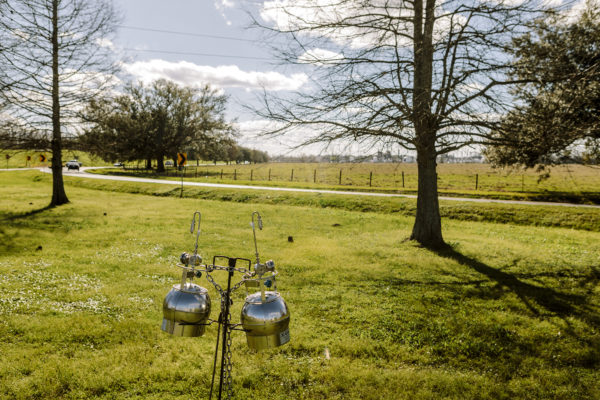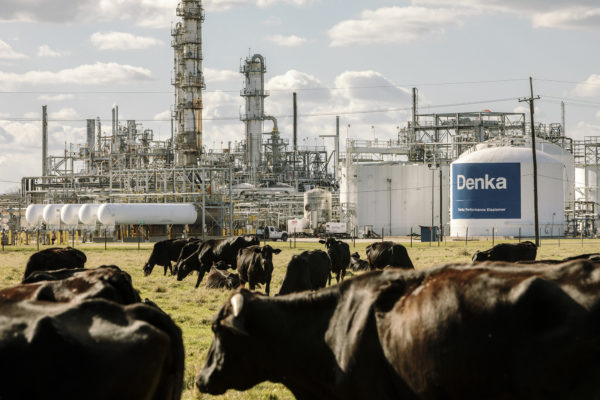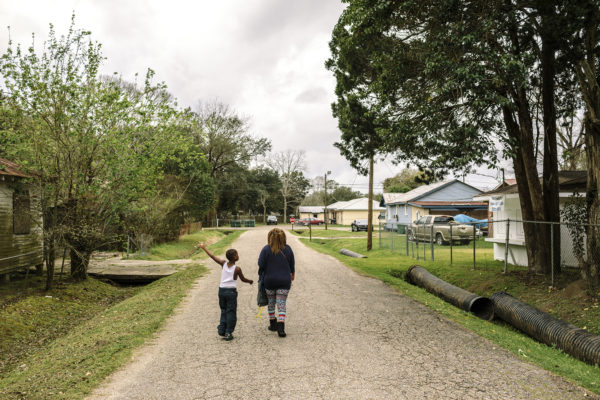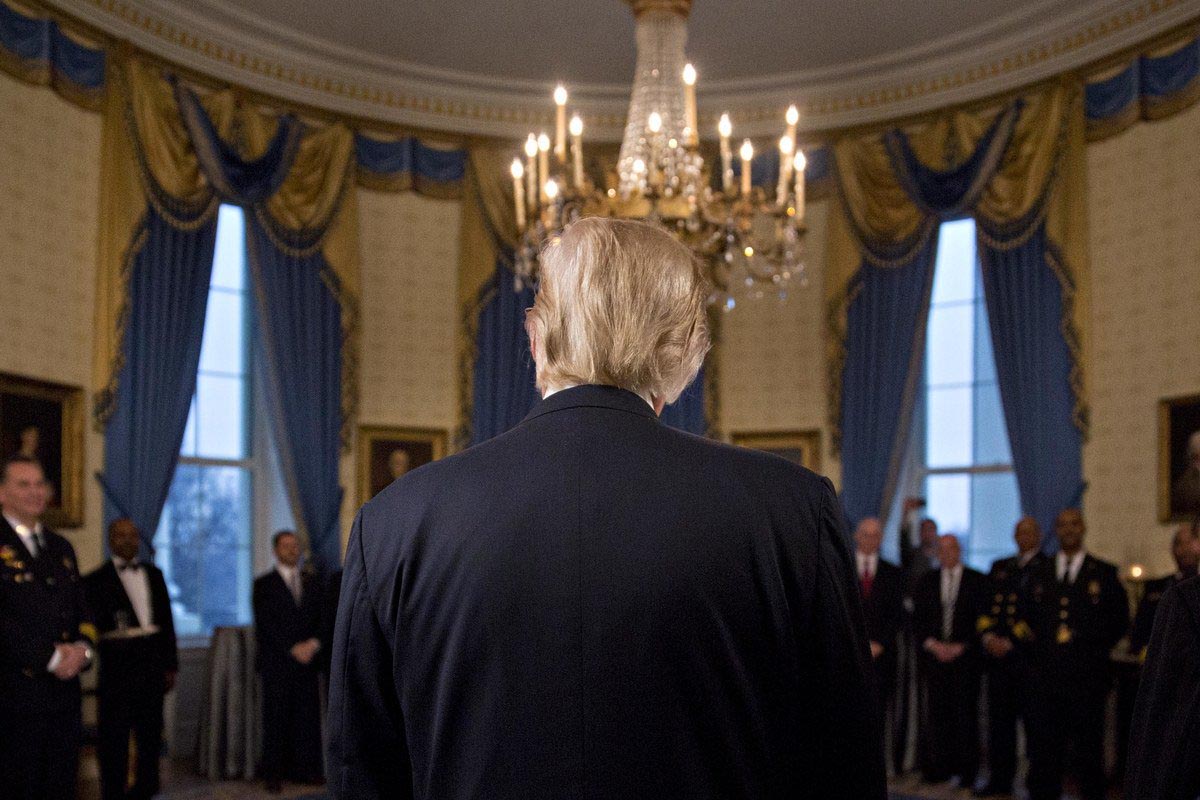Notes
Photography’s Limits in the Age of Trump’s EPA

On first glance, I find a strange loveliness in the instruments. The sun seems to shine directly upon them. They reflect spring grass, a pale blue sky, trees just beginning to bud. Their sensors are affixed by a slender reed of metal, bent into a graceful, cranelike curve. But then there are the dials, the valves, the heavy chain link. And then there is everything I can’t see, the airborne toxins that these devices are designed to detect. The far horizon of the picture reveals, blurrily, the reason that they are here: a Dupont/Denka plant that manufactures neoprene and, in the process, releases a chemical called chloroprene into the air. This photo illustrates a story, published on The Intercept, that tracks the insinuations of chlorprene into the lives and bodies of the people that live near the plant, and cites their otherwise-inexplicable ailments and mortalities as a warning about the human costs of Trump administration cuts to the EPA. Indeed, these instruments regularly detect concentrations of this likely human carcinogen hundreds of times higher than the EPA’s upper-level guidelines. But their mirrored surfaces, which refract our view as spectators, do not capture the plant on the side visible to us. And in providing this partial view, they serve as a visual metaphor for both the capacities and limitations of photography in the confrontation with human-engineered environmental crises.
Some such disasters make more visual sense than others. Oil spills, for example, like that of the Exxon Valdez or Deepwater Horizon often yield readily interpretable images: the damaged vessel, dead or dying wildlife covered in blackish sludge, prismatic slicks floating on the water. Photography, in these instances, serves a straightforward documentary purpose, and so renders obvious the magnitude and tragedy of the event. But oil is a highly visible culprit. Other hazards are not.
Once early photographers mastered the art and science of capturing what was readily perceptible, some practitioners turned to the challenge of imaging what humans otherwise would never be able to see. One quixotic consequence of this impulse was spirit photography, with its emphasis on capturing supernatural phenomena like auras, ghosts, and ectoplasm. Other pursuits were more practically minded, as, for example, when inventive photographers attempted to create machines that would record events that happened too fast for the human eye to detect them (like Muybridge’s galloping horse). Speed presented one obstacle, size posed another, and in turn animated the discipline of photomicrography. By the turn of the twentieth century, scientists and hobbyists alike were fusing instruments like microscopes with cameras to capture a range of physical, chemical, and biological phenomena and then enlarge them to a scale that would be accessible and interpretable to the proverbial naked eye. As both technologies advanced, photomicrography acquired an aesthetic dimension as well, so that the best photomicrographs were not only revelatory but artful as well.
This hybrid photomicrographic impulse also manifests itself in a range of efforts to document the pervasiveness and harms of various toxins, contaminants, and otherwise invisible environmental dangers. Radiation, with its connotations of mystery and transformation, has become a particularly appealing object for such visual experiments. The ghostly landscapes, uninhabited and overgrown, created by nuclear disasters like Chernobyl and Fukushima are photogenic in their own rights, but these images show effect, rather than cause. Alternatively, the task of making radiation itself visible requires novel forms of photographic image-creation. Alice Miceli, a Brazilian-born artist, devised a ‘radiographic’ process that captured both objects around the Chernobyl site and, she claims, the ambient radiation in the air, which appears in the images as a swirling fog. Greg McNevin, an environmental photographer, developed a technique that links long exposure times with data from Geiger counters and an LED display to record live radiation data around both Chernobyl and Fukushima. The end result, reminiscent of a bar graph overlaid on an otherwise unremarkable scene, is authoritative. But such images do not capture the consequences of what they so plainly depict.

By contrast, the photos illustrating the story of St. John the Baptist Parish approach the question of invisible contaminants rather elliptically. Within the story, much of the evidentiary work falls not to the photos but the text, which relays residents’ accounts and data on the undeniably toxicity of chloroprene, strongly inferring—rather than directly claiming—a link between the two. Indeed, the primary way that residents detect something amiss is not through sight but smell; the author quotes their vivid descriptions for the poisonous air, and her own embodied experience of it, but this is not something we can see. This kind of menace does not lend itself readily to being photographed. The photographer approaches most directly the suffering caused by the chemical, the plant’s evasion of environmental regulations, and governmental disinterest in pursuing it with a shot of framed family portraits of people killed by cancer. But the other images attend more to latent future harm, particularly by focusing on the parish’s children.

Often photographed wearing shades of red, white, and blue, the children play basketball, ride a dirt bike, or mug for the camera. And even as the adults recount stories of asthma, visits to the emergency room, and days confined indoors to avoid the smell, the children appear defiantly vibrant and active. The photos testify to their humanity, agency, and resilience, but do not (cannot) show the thing that may end up killing them.
One follows a boy and young woman as they walk home from school and dramatizes this dilemma. The context of the article tells us that these two young people are in peril; the caption points out that they are only one block from the plant, but it is nowhere visible in the image, which appears unremarkable. The neighborhood is tidy, and although the houses are small and some are showing a bit of age or neglect, most appear to be carefully kept. The grass is green, the trees are coming into leaf, and the sky is gray but not ominous. The boy, looking up at his taller companion, points animatedly to something (though we cannot tell what). His skin is very slightly lustrous; she wears leggings in a bold print, and despite the lack of sunlight, her braids are bright, almost golden. They look contented enough, but we are meant to mourn a tragedy that may already be unfolding underneath their skin.
Next to them, in a detail that we might easily overlook, a spotless white house flies a custom-printed banner wishing someone named “Mama Rita” a “Happy 100th birthday.” Mama Rita is not mentioned in the article, and does not appear in the frame. But her longevity here signifies ambivalently. It hints at the possibility of good fortune, good health in this ostensibly unlucky and unhealthy place. But this, in turn, gives fodder to the denials of the corporate spokespeople who insist that all is well, or getting better. Simultaneously, it also implies decades of breathing this air, gradually amassing this body burden, and waiting for someone to take notice.
— Rebecca Adelman
Photos: William Widmer for The Intercept. Caption 1: Two air-quality monitoring devices are mounted on public land near the Dupont/Denka plant in Reserve, St. John the Baptist Parish, Louisiana, on Feb. 24, 2017. Caption 2: Reserve, LA – Feb 24, 2017 – Cows graze on land bordering the Dupont/Denka plant. Caption 3: A young boy walks home from school along Robinet Drive, one block from the fence of the Dupont/Denka plant in Reserve, St. John the Baptist Parish, Louisiana, on Feb. 20, 2017.


Reactions
Comments Powered by Disqus